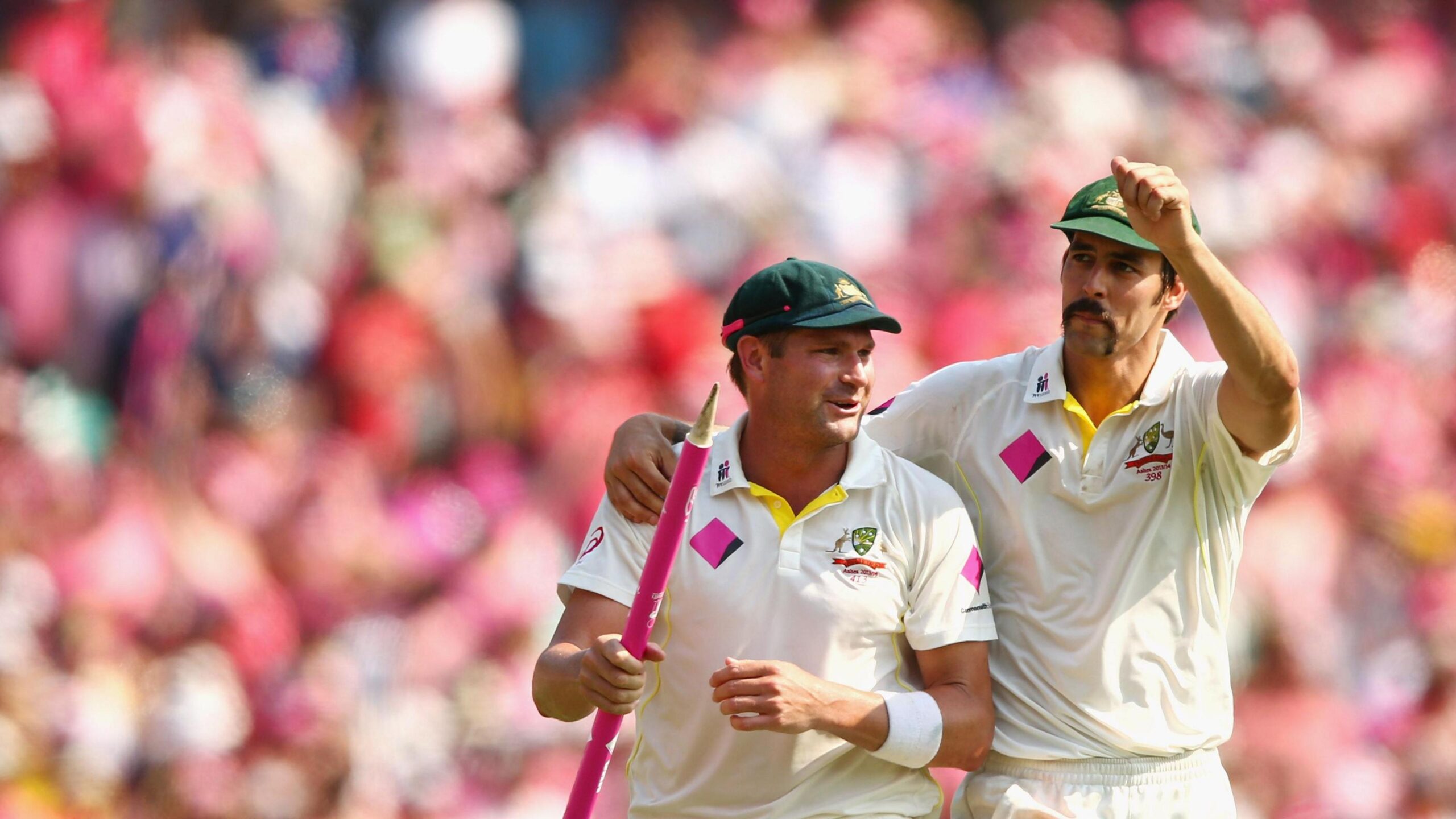History has had some great supporting characters.
Not sidekicks. That would be disrespectful. The number twos – those who make the stars shine that little bit brighter.
Brian Clough had Peter Taylor. Elton John had Bernie Taupin. Elsa had Anna.
Mitchell Johnson, the moustachioed menace who destroyed England at the speed of light, had Ryan Harris.
The 2013-14 Ashes, when England were humiliated 5-0, will forever belong to Johnson. The left-armer was pure pyrotechnics, battering stumps, pads and helmets, for his 37 wickets. At the other end, new-ball partner Harris was every inch his ‘Rhino’ nickname – rampaging and relentless.
It was Johnson who walked away as an Ashes legend, but Harris who produced ESPN Cricinfo’s ‘ball of the century’, a physics-defying in-outer to bowl England captain Alastair Cook. Kevin Pietersen called Harris the best Australian seamer he ever faced, and KP took on Johnson, Glenn McGrath and Brett Lee.
There were plenty of reasons why Harris might never have pulled on a baggy green cap.
His father was born in Leicester, meaning Harris could have played for England. An attempt to spend time with Sussex as a local player in 2008 was aborted. Before then, a younger Harris who liked “drinking beers” was let go by South Australia, only to regain his state contract as a first reserve when another player rejected theirs.
With a second chance, Harris realised he could add some pace to his bowling, and a move to Queensland helped fulfil his potential. Still, a troublesome right knee, a hangover of schoolboy injuries sustained fielding and playing Aussie rules, would plague and ultimately end his career.
He did not make his Test debut until the age of 31 – just before an Australia side in transition was famously humbled 3-1 on home soil in 2010-11 by Andrew Strauss’ team. It remains the last time England won down under.
“They were just relentless,” Harris tells BBC Sport. “I just remember walking into changing rooms at breaks thinking ‘what do we have to do to get these blokes out’.”
As his team suffered, so too did Harris, breaking his ankle in the fourth Test. Nothing compared to the misery of Johnson, whose game fell apart to a soundtrack of taunts from the Barmy Army. He bowls to the left, he bowls to the right. You know the rest.
“For the first time in his career he was challenged and the ball wasn’t coming out anywhere near what we would have liked,” says Harris. “Mentally, he started second guessing himself.
“That happens when there is so much pressure on. He was there to intimidate and bowl fast, but he couldn’t quite get that.”
Harris’ next crack at the English, in 2013, was just as problematic for Australia.
A chaotic build-up, including controversy over homework and David Warner punching Joe Root in a Birmingham bar, culminated in Mickey Arthur being replaced as head coach by Darren Lehmann.
“Boof had a massive meeting about how we all have to be in it together,” says Harris. “We had team values Mickey had drawn up – starting with ‘I will do this, I will do that’. Boof flipped that. He changed the ‘I’ to ‘We’. It was all about us being together.”
Australia found themselves 2-0 down, but could have won all the last three Tests before ultimately losing the series 3-0. There was a return series in Australia straight away, and Harris sensed the shift in momentum.
“You look at it on paper and it’s one of the worst results, but we thought it was way closer than that,” he says.
The other reason for Australian optimism was Johnson. Not part of the Test series in the UK, he came in for the one-dayers that followed. Johnson 2.0 was bowling rockets and unsettling England batters.
“We spoke a lot about it,” says Harris. “England knew what they were coming back against.
“We went through the footage. Seeing the way he was, we knew there might be a bit of a chink in their armour and it planted a pretty big seed for us for what to expect on our wickets.”
Australia captain Michael Clarke knew his team were on to something. “It wouldn’t surprise me in a couple of months’ time to see Mitch [Johnson] being man of the series,” Clarke said before the first Test.
Assembling his pace attack of Johnson, Harris and Peter Siddle, Clarke tasked his pacemen with neutralising Alastair Cook, the England opener Australia could not get out three years earlier.
“Michael Clarke pulled the fast bowlers aside,” says Harris.
“He said ‘you guys are going to win this for us. We’re going to target Cookie, make sure he’s not getting off to a good start’.
“We went through every plan we had for each batter, then Mitchell did what he did.”
In the first Test in Brisbane, it was Harris who sparked England’s first-innings collapse from 82-2 to 136 all out. In the second innings, Johnson took five as the tourists were not only hammered, but also left in no doubt of the aggression they were up against.
Facing up to Johnson, England number 11 James Anderson exchanged words with short-leg fielder George Bailey. Clarke intervened and was heard on the stump mic using an obscenity when warning Anderson to “get ready” for a broken arm.
“That surprised a few of the players as well,” says Harris. “Michael was vocal around the team, not necessarily to opposition players, and Jimmy got under the skin of most players at times.
“We wanted to play that way. We wanted to be aggressive, but we didn’t have a plan to go hard with verbal stuff.
“When we heard the words Michael said we all thought ‘ooohhh, that’s cool’. We knew he was in it with us, but that was a little bit of a shock. It was like ‘right, we’re on here’.”
Despite leading English lambs to slaughter at the Gabbatoir and with England number three Jonathan Trott leaving the tour, Harris did not feel like Australia were “definitely on top”. After all, Australia had only just notched a second Ashes Test win in 11 attempts.
In the second Test in Adelaide came irrefutable evidence the Johnson juggernaut would not be stopped. A first-innings 7-40, including a burst of 5-16 in five overs, flattened England – including debutant Ben Stokes – once more.
Three years on from a public humiliation, Johnson was carving his terrifying redemption, with Harris one of the few that witnessed both sides of the story.
“What happened in 2010-11, it hurt him and it did get to him,” says Harris. “He would say now that he was so intense, a fiery character, that everything anyone said would get to him.
“He had a big break that made him realise cricket wasn’t the only thing. He liked cars, he had business interests and he had a young daughter. He worked out that putting everything into cricket wasn’t healthy for him. He came back refreshed.
“The bowlers in 2013-14, we were really tight, and we still are. We spent a lot of time together and we didn’t talk cricket all the time. When it came to the cricket stuff, we communicated so well. It was almost a team within a team. We were so focussed on what we had to do.
- 27 October
- 20 October
In Perth, with the opportunity to win back the Ashes at the earliest opportunity, Australia were dismantling England once more. Despite their clear superiority, jitters were present for a home side that last won the urn more than six years earlier.
“I couldn’t sleep, so got up early, and went down to the team room at about 5:30am thinking I’d get an early coffee,” says Harris.
“There were seven or eight players in there, because they were so nervous as well.”
For Harris, the career-high of an Ashes win would come with the delivery for which he will always be remembered.
Bailey clobbered 28 from one Anderson over and England were set a notional second-innings target of 504. Cook took strike, Harris had the ball. What followed, from the first ball of the innings, bordered on sorcery.
Harris presented a seam as upright as a King’s Guard. Swing in to left-hander Cook, landing just beside a crack that zig-zagged down the Waca pitch. From a leg-stump line, the ball appeared to then move in the air in the opposite direction, past Cook’s crooked grope to kiss the top of off stump.
Cook was left befuddled, defeated – both feet pointing down the pitch. Harris was off on a celebration run that would have ended in the Swan River, had he not been mobbed by his team-mates.
“My body was hurting a bit,” says Harris. “I was running into bowl and halfway through the voice in my head said ‘stop’. I didn’t. I don’t know why I didn’t.
“The ball came out and it just felt good. The rest is history.”
Harris, now head coach of South Australia, is speaking from Perth the night before he is back at the Waca, leading his team against Western Australia in the Sheffield Shield.
“I came here last year and the guys I coach gave me a bit of stick about it,” he says. “I put a ball on the spot around where I thought it pitched. They enjoyed that.
“My little boy has friends at school who have seen it. He has no clue. Ball of the century, it’s what people want to label it. That was my job and it’s what I was trying to do.”
Australia celebrated in Shane Warne’s villa, and Harris had to apologise for a drunken tweet after being refused entry to the Crown Casino. It was a minuscule problem compared to what England were going through.
Graeme Swann retired and the tourists were Johnsoned once more in the fourth Test in Melbourne.
Harris saved his best, of the series and his career, for the final rout of a broken England in Sydney. His match figures of 9-106 included an edge off Boyd Rankin that completed the 5-0. Johnson and Harris took 59 wickets between them, pretty much bowling out England six times as a partnership.
“It was all about the Mitchell factor, the pace he bowled at and the way he took wickets,” says Harris.
“I’m sure there was some sort of fear in ‘how are we going to play Mitchell Johnson, when he’s bowling that way?’.

Harris wasn’t done there. Two months later he was bowling Australia to a superb away series victory over a powerful South Africa. In the deciding third Test, Harris could barely walk, yet his seven wickets in the match secured a thrilling win.
He underwent knee surgery immediately and returned for the following home summer to play three Tests against India. Battling to find full fitness, he was included in the Australia squad for the Ashes series in the UK in 2015.
“I was bowling in a warm-up match at Kent and I had a click in my knee that felt different,” says Harris. “I went back out and bowled, and bowled pretty well.
“I had a scan after the game. I’d cracked the top of my tibia.”
Faced with retirement and missing out on one more Ashes dance, Harris was a “blubbering mess”. Despite another crushing injury setback, he was considering more surgery in an attempt to prolong his career.
At the very end, Harris’ old mates and comrades Johnson and Siddle were there for him.
“I sat down with Mitch and Pete and said ‘I reckon I can do it again’,” says Harris.
“I used to have to take so much medication and Mitch said ‘I’ve seen what you have to take to be able to play, you can’t keep doing that because it will rip your stomach apart’. Pete was the same.
“That’s how close we were. We cared deeply for each other. They saw the fluid being taken out of my knee, how painful it was. They saw the scans.
“I had a bit more of a think, spoke to my wife, my brother and my dad, and I had to pull the pin.”
Of Harris’ 27 Test caps, 12 came in Ashes contests. Half of his Test wickets were England batters.
Of bowlers to make their debut since 1900 and take at least 50 Ashes wickets, Harris has the third-best average. Using the same criteria, his strike-rate is only bettered by Johnson.
“From watching Ashes cricket, the dream was to play it,” says Harris.
“Yes, I’d loved to have played more Tests, but I timed it right – when I wasn’t injured it was for an Ashes series.
The Ashes: Australia v England
Related topics
- Insight: In-depth stories from the world of sport
- Australia
- The Ashes
- Cricket
- 16 August







